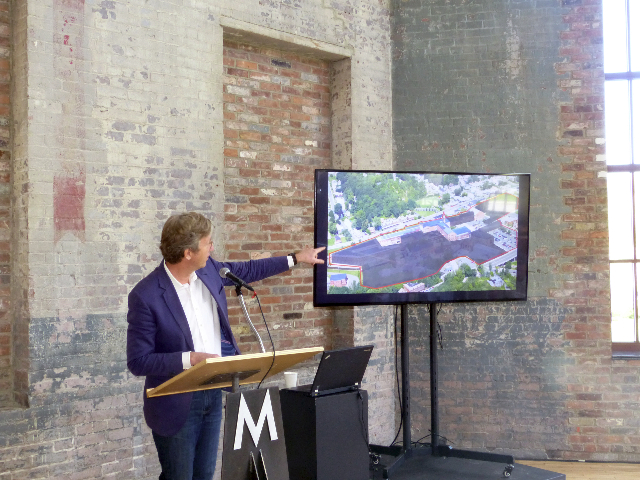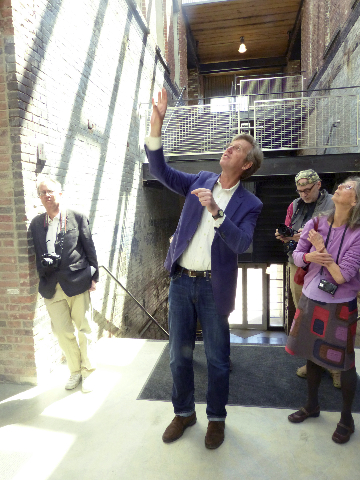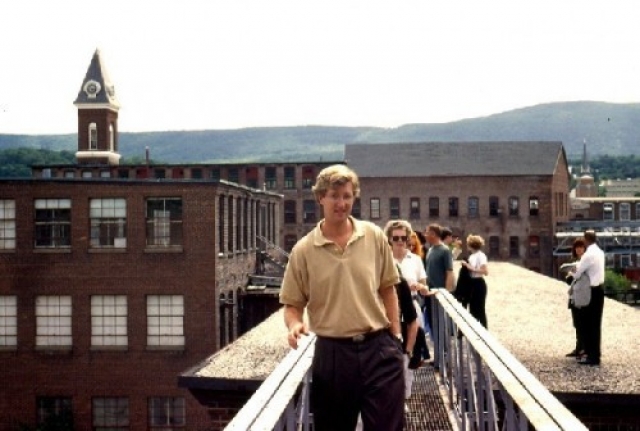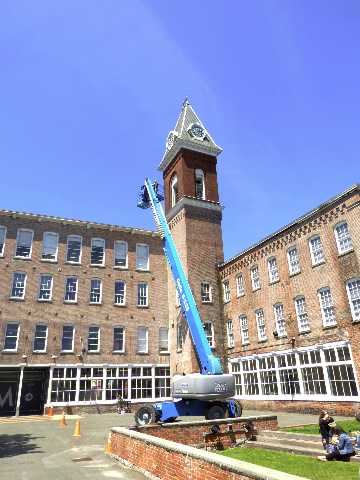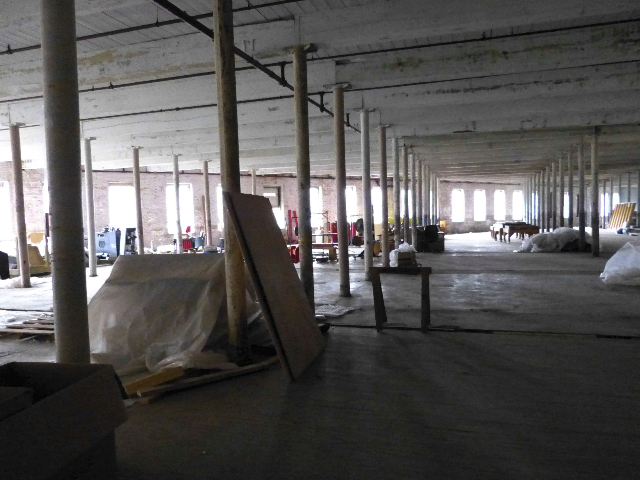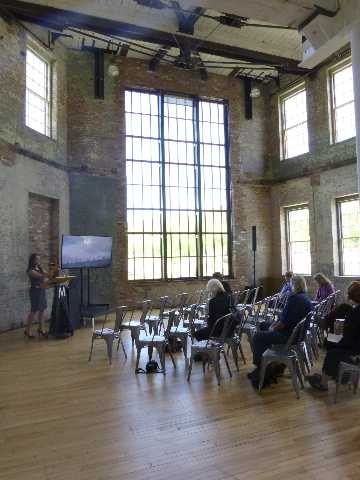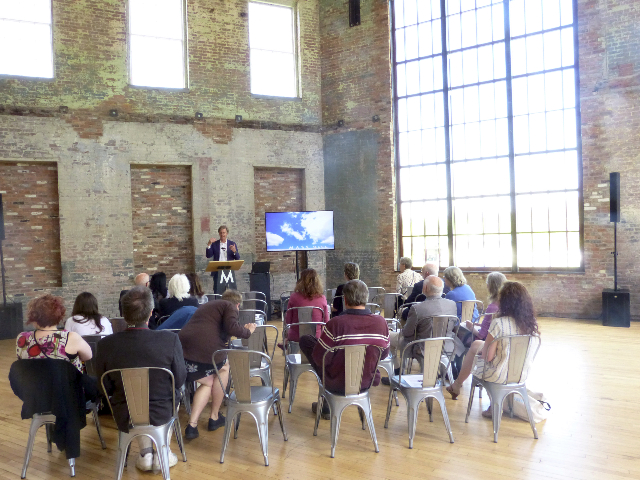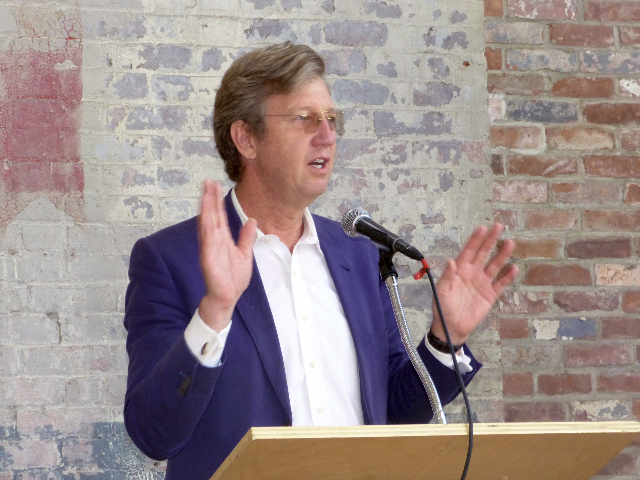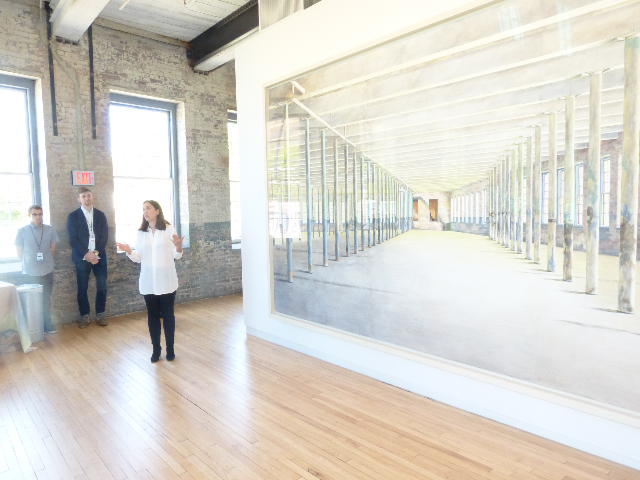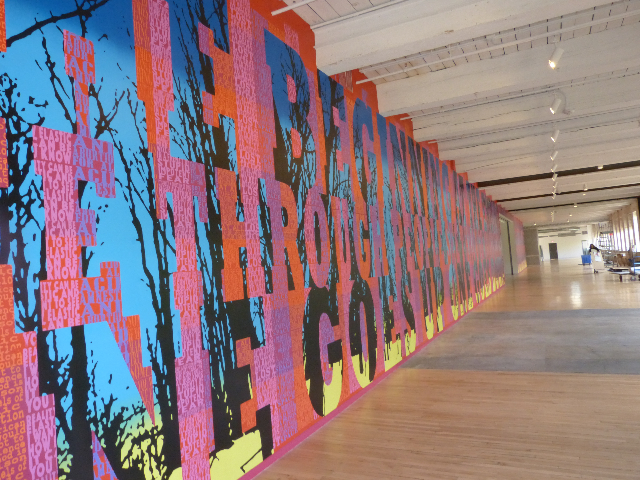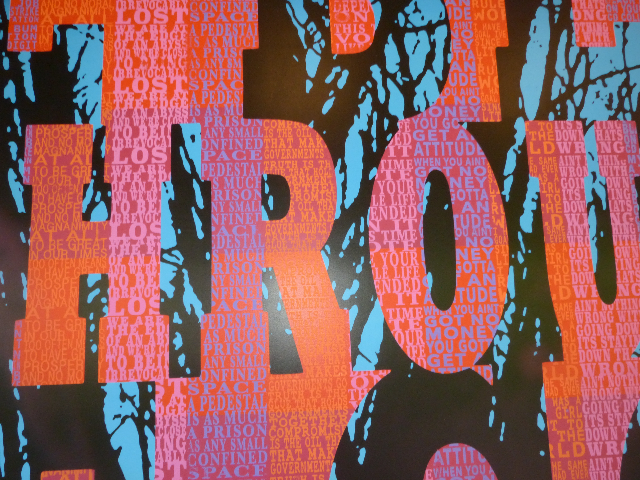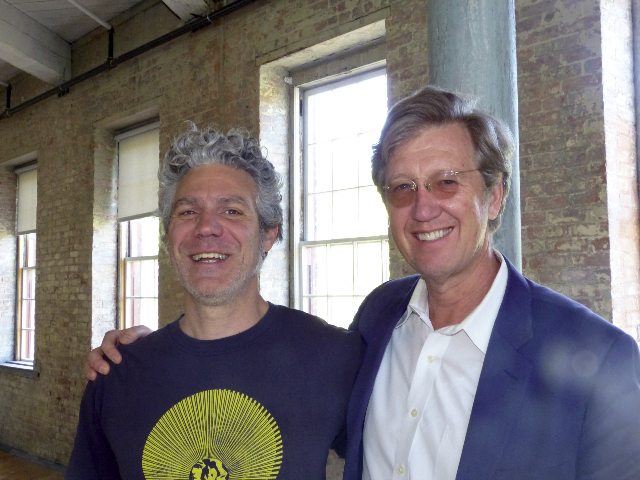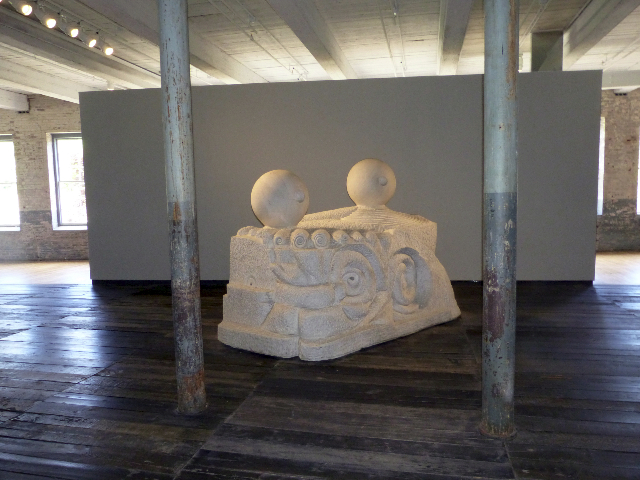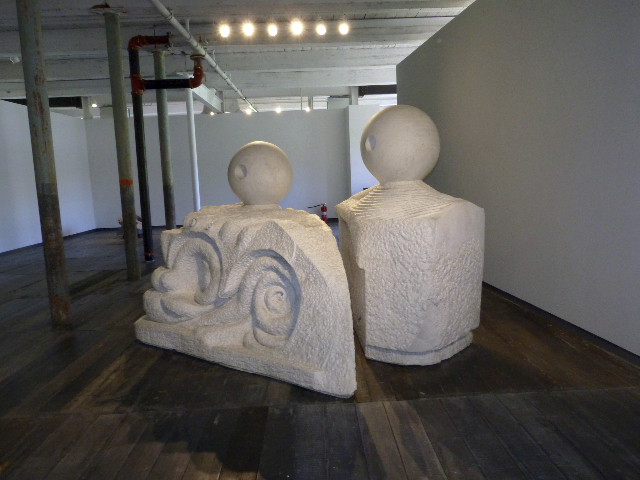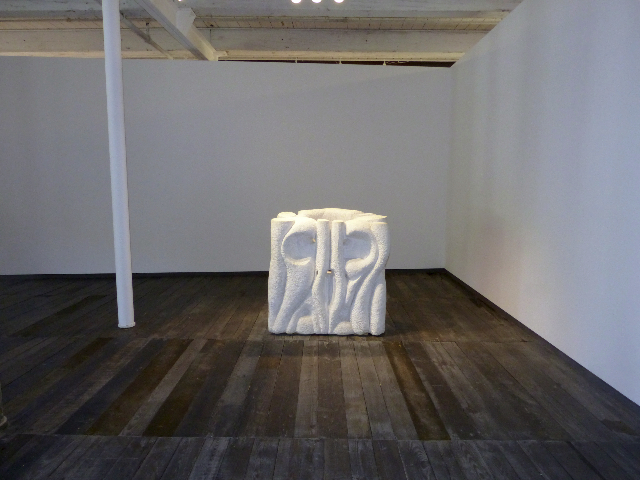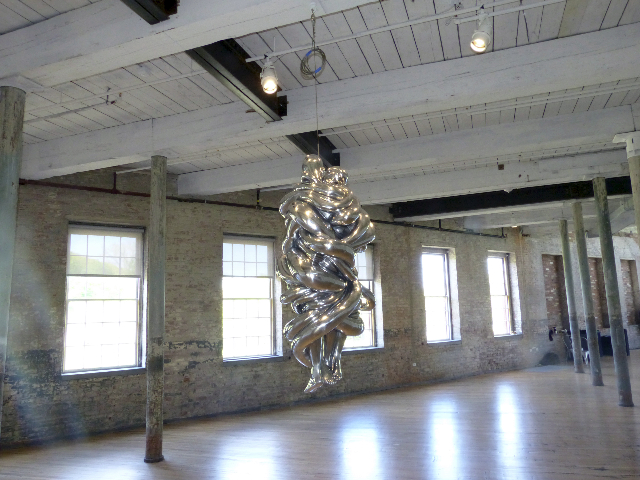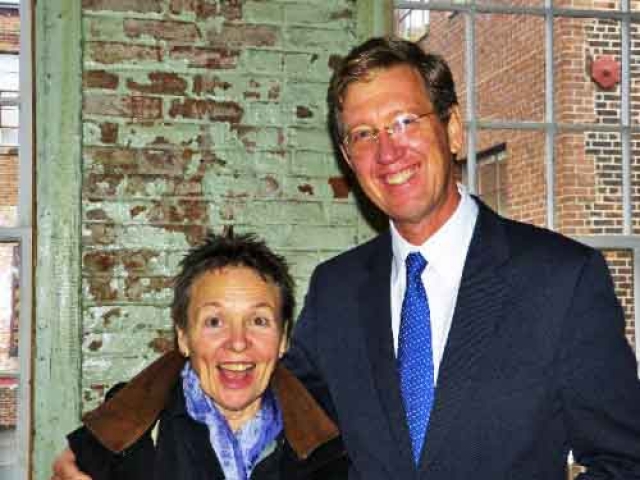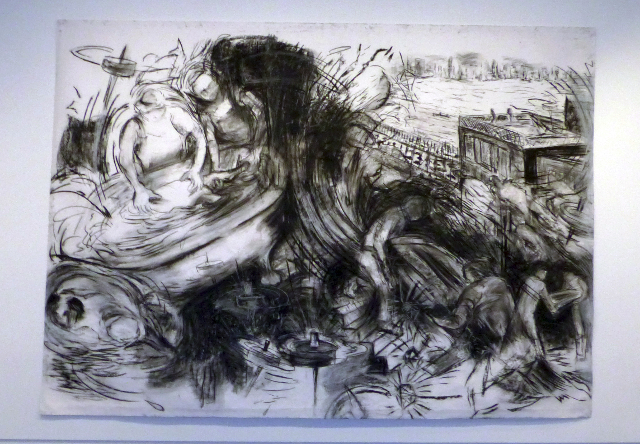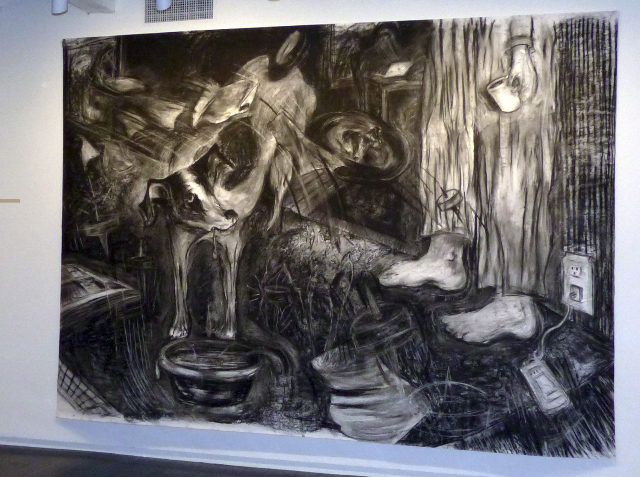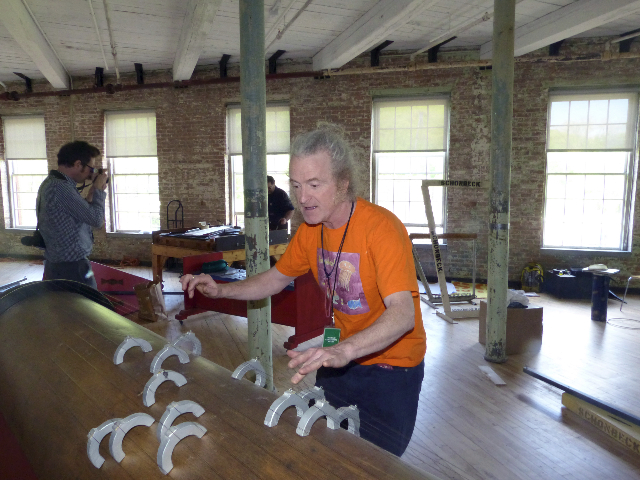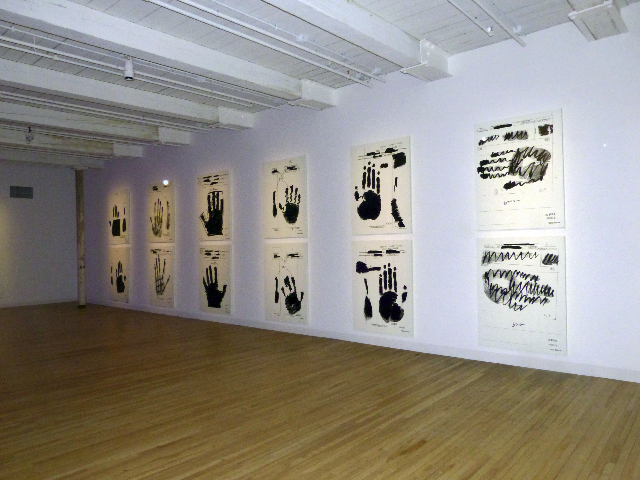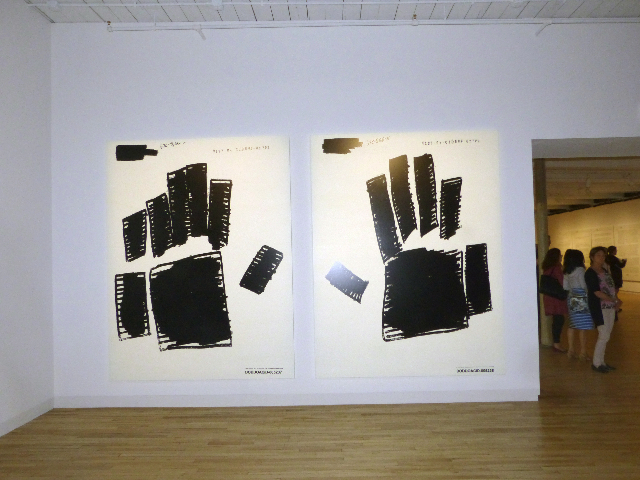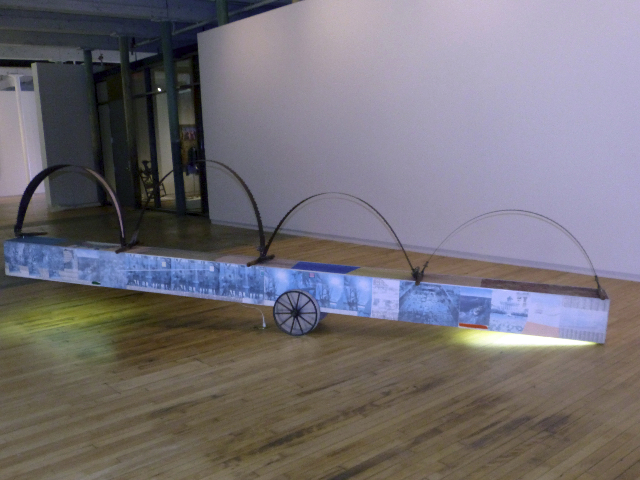Expanded MASS MoCA Galleries
Preview of May 28 Opening
By: Charles Giuliano - May 16, 2017
With considerable skpeticism MASS MoCA launched phase one of the development of the 17 acre, former campus of Sprague Elecctric Company in 1999. A bill to appropriate $25 million in seed money was passed in the final days of the administration of democratic Governor Michael Dukakis. The intial response of republican governor Bill Weld who followed Dukakis, famously, was "Over my dead body."
The third and final phase of development is now complete with the renovation of 130,000 squarefeet. It entails galleries, workshops, kitchens, dressing rooms for performers and visitor amenities.
The project including renovation and endowment came in at $380 per square foot. The norm for developing museums is ten times that. Part of that reflects the approach of not glossing over the bare beauty of iconic industrial spaces. The transformation has been minimally invasive and cost effective. A part of that entails restoring but retaining enormous windows. Natural light was essential to manufacturing prior to Edison. It is a feature that has been preserved and enhanced.
Through solar panels, wind power and other efficiencies, over the years, MoCA has reduced energy cost despite increased demand.
The primary feature of the new wing will be long term display of works by several renowed living and deceased artists; Laurie Anderson, Louise Bourgeois, Jenny Holzer, Robert Rauschenberg, Gunnar Schonbeck and James Turrell. Some displays will rotate and evolve over the next 15 years and a few will be permanent. This is similar to the concept for the prior buildings developed to display works by Sol LeWitt and Anselm Kiefer. There are ancillary and corridor spaces for temporary installations.
Vast Building Six at MASS MoCA narrows into an opened up space like the prow of a ship. A floor was removed creating a soaring vista some 28 feet high looking out on soon to be created biking and nature trails.
With a power point delivery Joe Thompson, the director of the largest contempoprary art museum in North America, used maps, spread sheets, charts and overlays to locate the museum as the epicenter connecting the dots of old and new cultural institutions.
His presentation conflated the aesthetics of displaying world class work in a paradigmatic, renovated 19th century industrial complex and a galvanic force driving the ecomonic engine for the long depressed Northern Berkshire community.
Between museums, theatre, performances and music festivals there is now the critical mass of activity to change the pattern from day trippers to weekenders and vacationers. That has the impact of moving the needle for a range of new motels, hotels, restaurants and shops that are sprouting like weeds on the cultural axis connecting MoCA in North Adams to Williams College, the Williamstown Theatre Festival and the Clark Art Institute.
In vacant downtown storefronts there will be a variety of popup projects this summer from retail to recreational. The activity will include concerts, performances outdoor movies and expanded activities. As Thompson put it the museum is generating a "breadcrumb trail" leading visitors to downtown. Until now, at the end of the day, they hopped into their cars and drove away. "We want them to stay and spend their money here," he said.
This summer there will be expanded sound and light works downtown. From dusk to 11PM Steeple Town's famous spires will talk to the MoCA tower and the beacon on Mt. Greylock. In a Morse Code piece called "Cloudland" they will spell out a stanza by Henry David Thoreau.
The museum has initiated soundworks including under the Route 2 overpass adjacent to the museum campus and another at Natural Bridge State Park that plays every night at sunset. Two more will be added downtown.
This summer finding a room will be challenging with additional hotels already in the planning stage. The tougher issue for entrepreneurs looking to invest in the region is the low rate of occupancy in the off season. Thompson oberved that to make it work there has to be more emphasis on progamming in the shoulder seasons and dead of winter. That can only occur through the synergy of local cultural resources.
There is a demographic base to build on with Williams College and MCLA as well as an ever expanding community of artists and those attracted to a rural environment with big market cultural resources.
After decades of stagnation commerical properties are selling to developers. Artists have seen the equity in their lofts double and triple from what they paid a dozen years ago.
Following opening remarks Thompson led a gaggle of reporters on a brisk hour and a half tour of the galleries. An intern was assigned the task of walking through and clocking the running footage of a great loop through the museum complex. It comes to some 4.5 miles. That's a lot of art to look at. Hopefully visitors will spread out all there is to see and do so over a couple of days.
MoCA has long been faulted by the local community for not doing enough to draw visitors into the largely vacant and depressed downtown. Thompson stessed that Main Street is an easy walk from the MoCA parking lots. This summer the gate will be unclocked connecting the border of the MoCA campus with Heritage Park. The area is under negotiaton for acquisition by a consortium led by museum developer Tom Krens. He is planning a train museum as well as a clock museum abutting MoCA. On land adjacent to the airport, which is being expanded and improved, he plans to launch a commercial contemporary museum/ gallery.
Referring to a question about this potential synergy Thompson stated that "Not everybody is enthusiastic about contemporary art but everyone loves trains."
A reporter pressed for figures about dollars and sense. There is always a fascination about how much things cost and how long it takes to create a complex building or work of art. That's where things get fuzzy and becomes a matter of how you run the numbers. The project, with installations and endowments may chime in at $65 million. It was made possible with seed money of $25 million from the state. There is some $10 million yet to be raised including $2 million for a James Turrell makeover of an abandoned water tower. As to attendance Thompson wavered back and forth before stating some 165,000 annual visitors. That includes museum visitors as well as performance figures.
There are, however, many wild card factors.
One fact, however, is absolutely sure. As Thompson put it, MASS MoCA never would have happened had it not been for the ongoing support of seven governors, both democrats and republicans, from inception to fruition.
Along the way there have been sceptics and critics. There were many dark times. But looking out from the dramatic prow of Building Six Thompson gazed at a bucolic horizon. That long anticipated better day has arrived at last.
MASS MoCA Press Release
On May 28, 2017, MASS MoCA will open its newly renovated Building 6, adding 130,000 square feet of space, nearly doubling the institution’s current gallery footprint and adding new art fabrication workshops, performing artists’ support facilities, music festival amenities, and other programmatic capacities. The centerpiece of Building 6 is a series of changing exhibitions and long-term installations and collaborations with artists Laurie Anderson, Jenny Holzer, and James Turrell, the Louise Bourgeois Trust, the Robert Rauschenberg Foundation, and the estate of Gunnar Schonbeck. Additional installation works include Sol LeWitt, Dawn DeDeaux and Lonnie Holley, Mary Lum, Joe Wardwell, Sarah Crowner, Spencer Finch, Janice Kerbel, Barbara Ernst Prey, and The Metabolic Studio/Optics Division.
Building 6 sits at the western perimeter of MASS MoCA’s campus, its prow-like triangular footprint shaped by the confluence of the north and south branches of the Hoosic River. Visitors will enter the new space through Building 5, the signature gallery for MASS MoCA’s large-scale installations, which will feature Nick Cave’s Until through Labor Day 2017, or through Building 8, where a light-based work by Spencer Finch has been on view since February 4. Building 6, a three-story post-and-beam building, is distinguished by the ample natural light that enters through the hundreds of windows lining the perimeter of the building. Additional natural light filters into the core of the building through a historic lightwell which was restored during this renovation, its roof replaced with a skylight measuring 20’ wide by 140’ long. This rediscovered space incorporates a new series of stairs and bridges that encourage easy movement between floors and across the two sides of the building.
“We love the way the building accommodates a powerful assembly of visual art, but also increases our capacity to host performers and the audiences who patronize our live events,” says MASS MoCA Director Joseph Thompson. “Building 6 encourages patrons to explore our entire 16-acre campus, opening a big, freewheeling, circulation loop, long site lines, and beautiful views onto inner courtyards and the neighborhoods and surrounding hills of North Adams.”
James Turrell
In James Turrell’s hands, light is more than a source of illumination: it is a discrete, physical object. Planes of light seem to float, suspended, in ceilings or walls; architecture disintegrates; brilliant geometric shapes levitate in mid-air. Turrell began using light as a sculptural medium in 1966, painting the windows of his studio in Santa Monica to seal off the natural light and experimenting with sunlight projected light through shades and blinds. A pioneer in the Southern California Light and Space movement, MASS MoCA will present a multi-decade retrospective of Turrell’s work in Building 6 — with galleries designed and constructed by the artist. This exhibition will feature at least one work from each decade of the artist’s career.
Gunnar Schonbeck: No Experience Required
Over a period of fifty years, Gunnar Schonbeck crafted an arsenal of more than 1,000 instruments, handmade from often simple materials. His works include a 9-foot banjo, an 8-foot tall marimba, drums made from aircraft fuselages, welded steel harps and countless steel drums, zithers, pan pipes, tubular chimes, and triangular cellos. His practice was built around his belief that anyone can be a musician and that every object contained within it an inherent musicality. Over the last five years, visiting musicians to MASS MoCA, including Bang on a Can’s Mark Stewart and Wilco’s Glenn Kotche, have drawn on Schonbeck’s instruments in their performances and projects. With this installation — which will look and feel like a high school band room, Schonbeck’s instruments placed in shelves lining the walls — visitors will be encouraged to play and make music of their own beat.
Jenny Holzer
Jenny Holzer’s concise, often enigmatic, writings infiltrate public life and consciousness through everyday objects such as t-shirts, posters, LED signs, and benches, as well as her paintings and sculpture. In her large-scale projections, which have now appeared in over 40 cities in 20 countries, stark block lettering is thrown onto landscapes and architecture, creating a sort of ephemeral graffiti that links her early street-based practice to her long-standing engagement with media, and to tactics common to news and advertising. Following her monumental installation in MASS MoCA’s largest gallery, Building 5, in 2007 — which marked her first indoor projection in the U.S. — Holzer returns with a campus-wide series of work that will include a large-scale outdoor projection on the River Street side of the factory’s complex, a series of her celebrated carved stone benches located throughout MASS MoCA’s sprawling campus, an exhibition of her early wheat-paste posters and additional rotating exhibitions of her work in Building 6, spanning the breadth of her career. Projections are scheduled to run Wednesday-Sunday nights, from May 17-June 25.
Laurie Anderson
Laurie Anderson is one of today’s premier multimedia artists, known for her work as a storyteller, composer, poet, photographer, filmmaker, vocalist, and instrumentalist. Her wide-range oeuvre includes the creation of books, albums, and performances that incorporate film, slides, recorded audio, live music, and spoken word. Anderson has long been recognized as a groundbreaking leader in the use of technology in the arts, and has developed new musical instruments, including the tape bow violin, in which the bow has been replaced with magnetic audiotape and the bridge with a reader. She was one of MASS MoCA's first artists-in-residence, and has returned to the museum many times to develop and discuss works-in-progress. In MASS MoCA's new Building 6, Anderson will create a multi-functional environment that will serve as a working studio and exhibition venue, highlighting both her creative process and over 10 years of archival work. The artist has crafted two virtual reality experiences with Hsin-Chien Huang, one of which recreates and enhances a gallery space in which Anderson painted every available surface by hand.
Louise Bourgeois
Louise Bourgeois described her artistic practice as an attempt to work through whatever tumult plagued her — psychologically, personally, artistically. Her work often references human anatomy and sexuality, in some instances overtly and in others more subtlety through organic and ambiguous forms. Her oeuvre encompassed drawings, paintings, textiles, embroidered works, sculpture, and installations ranging in scale from a few inches to fully immersive environments. She began working in marble in the early 1960s while living in Avenza, Italy, and the medium proved particularly compelling for the artist. In partnership with the Louise Bourgeois Trust, MASS MoCA will present three of the artist’s marble sculptures, as well as a cast aluminum work, The Couple, hanging in the foyer of a gallery space that will display the work for 15 years.
Robert Rauschenberg
Robert Rauschenberg believed that art could foster positive change across diverse cultures. This conviction led him to found ROCI (Rauschenberg Overseas Culture Interchange) and continues to inform the Robert Rauschenberg Foundation’s Captiva Residency program. MASS MoCA’s new collaboration with the Rauschenberg Foundation builds on convictions central to both organizations’ missions: the importance of the relationship between the fine and performing arts, of nurturing new works by established and emerging artists, and of the ability of the arts to affect real change in the world at large. Rauschenberg’s A Quake in Paradise (Labyrinth) from 1994 invites viewers to move through — and become a part of — a maze-like installation of panels printed with the artist’s signature layers of mechanically reproduced imagery. It is shown in tandem with The Lurid Attack of the Monsters from the Postal News Aug 1875, a 1981 sculpture from Rauschenberg’s Kabal American Zephyr series incorporating antique saws that is both threatening and playful.
Dawn DeDeaux and Lonnie Holley: Thumbs Up for the Mothership
An exhibition designed to give an extended public forum to two artists who have participated in the Captiva studio residency program of the Robert Rauschenberg Foundation, Thumbs up for the Mothership features works by New Orleans conceptual artist Dawn DeDeaux and Alabamian self-taught sculptor and musician Lonnie Holley. Deeply influenced by their Southern roots, both artists mine the landscapes around them for found objects (a nod to Rauschenberg’s “combines”) and address issues of ecological and social justice. DeDeaux and Holley believe that through art, they can “help heal the mothership.” Both artists experiment with mixed media and incorporate performance into their practice — ranging from totemic found objects and photography to experimental blues music and Afrofuturist philosophies. Holley states: “There are so many rocks and so many broken stones and so many nails and sticks and weeds and debris and garbage and trash. We have to plow and mine the worst things on this earth to make them better, and to make us better, so we can show the world: I can handle it. I can deal with it. I can live with it. I can go on.”
Mary Lum: Assembly (Lorem Ipsum)
Artist Mary Lum, who lives in North Adams, works in a range of media, including wall drawing, painting, collage, photography, and artist books. Language plays an important role in her practice, with the artist drawing on texts from a diversity of sources, including literature, psychoanalysis, and the news. This, along with an interest in the history of 20th-century design and typography, has led to the creation of a dynamic array of installations. For the opening of Building 6, MASS MoCA has commissioned Lum to create a large-scale painting for the bike tunnel that will run through the ground floor of the structure. The renovation and restoration of Building 6 includes the creation of a direct link to surrounding bike paths, allowing cyclists to move through campus and engage with outdoor installations without breaking with their routes. Lum’s monumental painting, measuring 12 × 30 feet, is inspired by Lorem ipsum, the text that graphic designers and typesetters use as mock content and which was originally drawn from Cicero’s writings on ethics. The intricate work moves between writing, image, and pattern, and speaks to the fragmented way in which we acquire information and see language in today’s digital world.
Sol LeWitt: Structures
A new adjunct to MASS MoCA’s long-running Sol LeWitt exhibition A Wall Drawing Retrospective, a concise selection of the artists’ three-dimensional sculptures will be on view in Building 6. The works illustrate the generative potential for LeWitt’s serial approach, exemplified by the museum’s monumental installation of the artist’s wall drawings — which span LeWitt’s entire career, covering over an acre of wall space on three floors of a building in the very heart of MASS MoCA’s campus.
Spencer Finch: Cosmic Latte
Spencer Finch, the focus of a major mid-career survey at MASS MoCA in 2007 titled What Time is it on the Sun?, returns to the museum with a long-term installation commissioned and designed in conjunction with the museum’s expansion. Bringing the starry night inside the museum, Finch’s light-based work, Cosmic Latte features over 300 specially fabricated LED fixtures that will be suspended from the ceiling over an expanse of the 80-foot long gallery. The constellation of LEDs are arranged in the gently arching shape of the Milky Way as it is observed in the Northern Hemisphere in March. The work’s title, Cosmic Latte, refers to the name of the average color of the universe, which in 2009 was determined to be a warmer hue than what has been traditionally thought of as blue. Two American astrophysicists studied the color of the light emitted by 200,000 galaxies and created a cosmic spectrum, which they then averaged according to the light spectrum visible to human eyes. Finch represents that specific warm, yellowish-white shade of light with LED lights (designed to look like incandescent bulbs), which are then arranged in the shape of the molecular model of the pigments needed to create this “cosmic latte” color: titanium white, Mars yellow, chrome yellow, and a touch of cadmium red.
Joe Wardwell: Hello America: 40 Hits from the 50 States
Boston-based artist Joe Wardwell’s Hello America: 40 Hits from the 50 States, a new wall drawing for MASS MoCA, takes inspiration from J.G. Ballard’s 1981 novel Hello America, a book that begins after an energy crisis in the late 20th century that leaves America all but abandoned. Wardwell fashions a layered wall work that looks at America through the lens of landscape imagery, political slogans, and song lyrics, beginning with a silhouetted line of bare winter trees taken from the slopes of Mount Greylock in the Berkshires. Over this, Wardwell paints a dusky post-apocalyptic landscape of yellows and blues. On top of it all he layers large letters — a slogan camouflaged within the landscape, with lyrics such as punk band Mission of Burma’s “Fame and fortune is a stupid game / Fame and fortune is the game I play.” The final layer is a series of smaller screen-printed texts — 40 texts for the top 40 hits — in repeated vertical bands. The “40 hits” are culled from a collection of quotes from various American sources ranging from past presidential campaign slogans, to ruminations on the end of the United States, to the role of government and the rule of law. The lyrics and texts quote works by Jello Biafra, Chuck D, Anne Sexton, Hunter S. Thompson, Abraham Lincoln, William McKinley, Bill Clinton, e.e. cummings, Barack Obama, Henry Rollins, Maya Angelou, and others. In the end, the work is a fragmented portrait in which the larger text, smaller slogans, and landscape function much like the assembled fragments of culture that the explorers in Ballard’s Hello America uncover in their epic journey across the forgotten land.
Sarah Crowner: Wall (Hot Blue Terracotta)
Sarah Crowner’s gorgeous 10 × 20 foot tile mural Wall (Hot Blue Terracotta) — fabricated for her recent MASS MoCA exhibition Beetle in the Leaves — now guides visitors in and out of the museum’s new gallery spaces. Known for her bold and graphic work in a variety of mediums spanning the fine and applied arts, Crowner finds the forms and patterns of abstraction in the everyday. Her monumental structure transforms painting into architecture (and vice versa), with the imperfections and eccentricities of the hand-glazed tiles functioning like a painter’s gestures.
Janice Kerbel: Slip
At once poetic and darkly comedic, Janice Kerbel’s Slip uses graphic musical notation to imagine the trajectory of a body in mortal peril as it slips on a banana peel. Moving from very small to very large print along an upward curve before suddenly crashing downward, Slip unfolds across more than 100 running feet of wall space in Building 6. The work calls on the history of graphic notation, physical comedy, and concrete poetry to create a visual representation of a brief moment across both space and time. Situated just outside of the new galleries devoted to the musical instruments of Gunnar Schonbeck and works by experimental musician and artist Laurie Anderson, Slip conflates visual art and musical performance — cornerstones of MASS MoCA’s program — at a grand architectural scale.
Building Portraits
To celebrate and document Building 6, MASS MoCA commissioned two works, one interior portrait in watercolor and an exterior photograph. Artist Barbara Ernst Prey has painted a monumental watercolor for MASS MoCA’s expansion — perhaps the largest watercolor painting ever completed by a living woman artist. At 9 feet tall by 16 feet wide, the work depicts the interior and prow of Building 6 just prior to the start of construction. Best known for her plein air paintings, Prey’s commission tackles the vast horizontal spread of Building 6’s second floor, which comprises a full acre of floor area, with some 400 columns, hundreds of windows, and layers and layers of paint. The Optics Division of the Metabolic Studio spent a week at MASS MoCA in fall 2016, using its mobile pinhole camera and darkroom fashioned in a sea container to create a series of portraits of Building 6. The artists collected water samples from the Hoosic River, which were then poured over the paper during printing, imbuing the image with ripples of river water. The name “Hoosic” is derived from the Native Algonquian meaning “The Beyond Place.”
Richard Nonas: Cut Back Through (for Bjorn)
Following his ambitious exhibition in Building 5, The Man in the Empty Space, Richard Nonas has created a long-term, outdoor installation in granite for the museum grounds. For five decades, he has made works that alter our sense of landscape and architecture — of place — using the simplest of means. His vocabulary includes pared-down forms and earthy and industrial materials that have a timeless, even totemic quality. Nonas has now reimagined the southeast corner of MASS MoCA’s campus with Cut Back Through (for Bjorn), a new arrangement of the three large granite chairs and five granite stools first seen in MASS MoCA’s galleries. Nonas often changes already-existing works into new combinations, and thus new works. And like Cut Back Through (for Bjorn), many of his works are often arranged in pairs, series, or grids which create a dialogue and tension between the individual elements while creating a new whole from these parts. The grouping of granite sculptures functions as a cut into the landscape, but they also offer museum-goers a place to rest both their bodies and minds, allowing for — and indeed provoking — intuitive, visceral responses.
“There is a language of place, and it is the most direct human language there is; the most basic way to impose human order and meaning on an outside, non-human world.” — Richard Nonas
Sponsorship
Major exhibition support is provided by the Horace W. Goldsmith Foundation, the Barr Foundation, and the Massachusetts Cultural Council.

